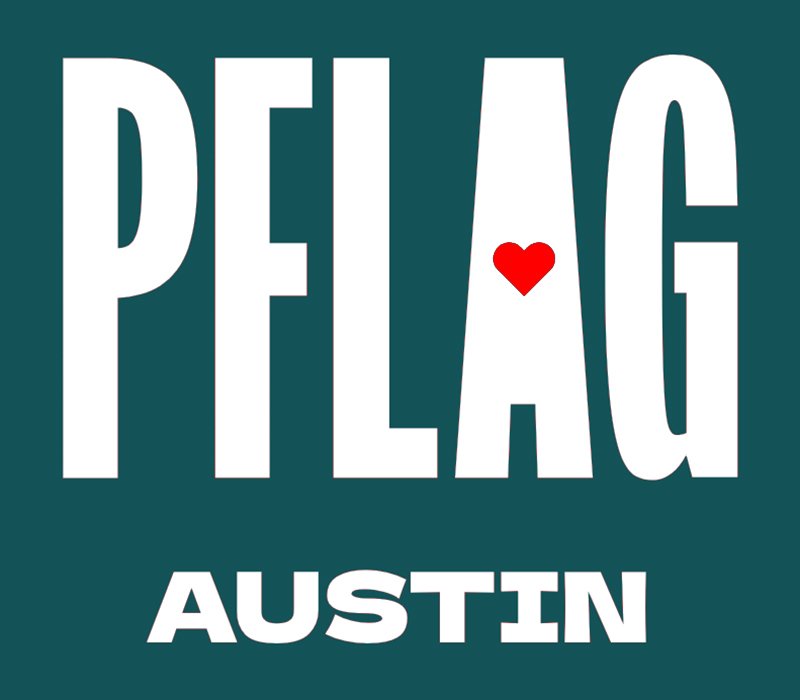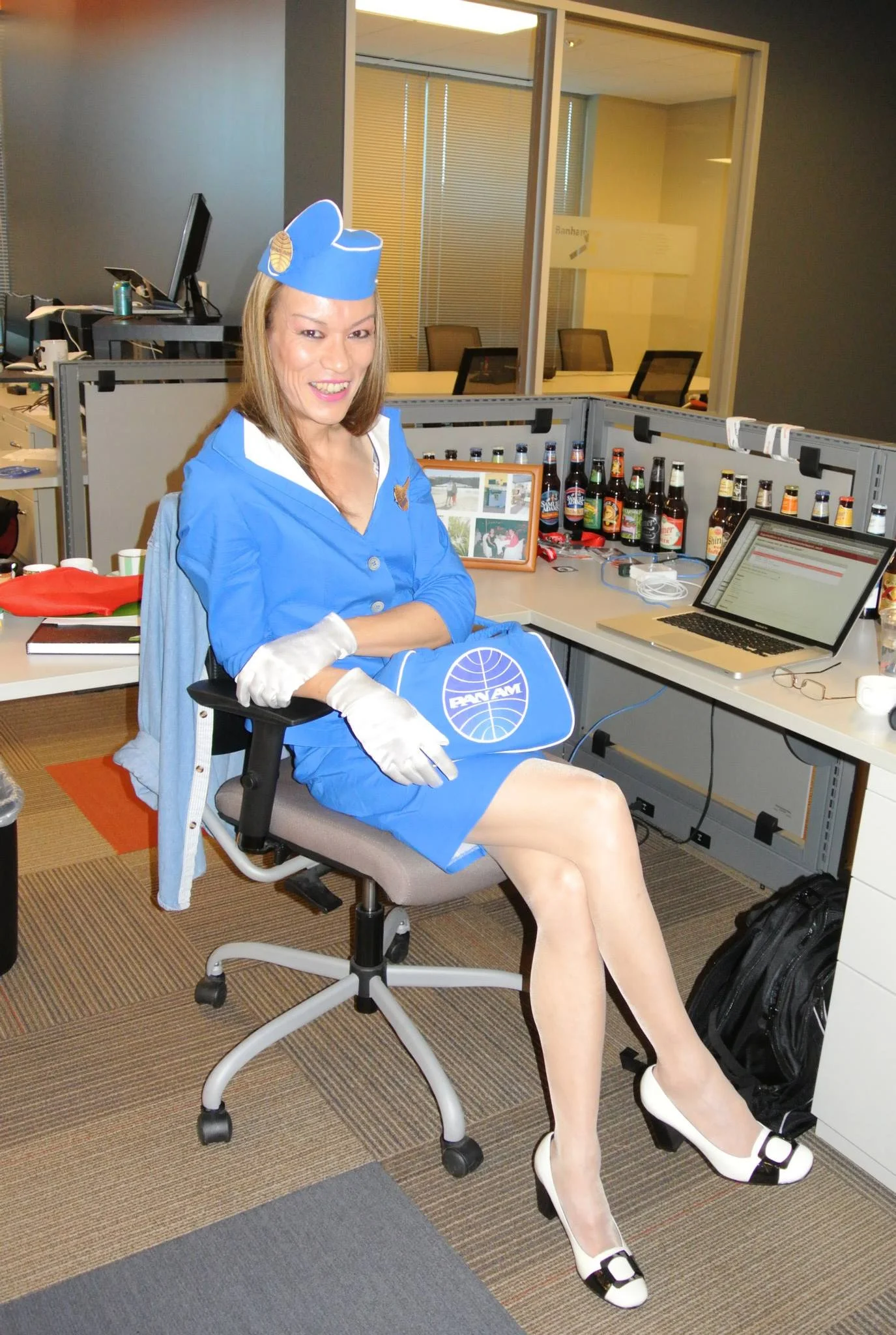Anna Nguyen “Speaks Up And Sticks Out”
In 2014, transgender woman Anna Nguyen decided to use a costume to stop hiding. It was Halloween, and Anna, a software engineer, had also become a skilled fashion designer and seamstress.
“I was still presenting as male at the time,” says Anna from the Whole Foods in downtown Austin. She looks out from behind cropped blonde bangs and smiles. Anna is a woman accustomed to stares, not because she transitioned in her fifties, but because she is strikingly beautiful—one double-take away from Spice Girl and just as spunky. For someone who recommends “dropping hints” as a way to seek out LGBTQ allies, her choice for a Halloween office party costume was bold.
“I made myself a Pan-Am stewardess uniform, complete with a cap and flight bag,” she says. “We had a costume contest, and I won by a landslide. Of course, everyone was impressed by how great I looked and how in character I was.” The costume helped Anna’s colleagues transition along with her the following July. “I suppose that people maybe were surprised, but it wasn’t a complete surprise because they had seen a side of me that foreshadowed who I am. So I came out, and it was great.”
Nonetheless, coming out was not an easy choice. “I came out when I was 54, and even for me as a grown adult, it was hugely scary. The thing that really crystallized my decision was I asked myself, Would I rather spend the rest of my life as a woman or as a man? The answer was so clear.” Though she had been taking hormones, Anna found the social transition especially daunting. “Physically, it wasn’t an irreversible decision, but socially—once I come out, it’s pretty much irreversible. Coming out is kind of like taking off a Band-Aid. I can hem and haw and go about it slowly or I can just rip it off.”
Coming out to her family was another important step. Born in London, Anna grew up in Vietnam. She fled to England in 1975 when South Vietnam fell to the Communists. Anna’s parents, who are in their late eighties, are devout Catholics and were initially non-accepting. “But when one knows someone close to them who is gay or trans, things change,” Anna explains. After recognizing Anna’s happiness, her mom is now “okay with it,” and her dad, whom Anna describes as “more informed,” “has been able to learn more and grasp the concept of somebody being transgender.”
“I still remember the first time he called me Anna,” she says. “That was one of the sweetest sounds I could have heard.”
The rest of Anna’s family—three siblings and her cousins—have all been supportive. Upon hearing the news, Anna’s sister told her that she had always wanted a sister. One of her brothers, however, needed time to adjust. Before a family Thanksgiving gathering, he said that he would rather Anna not participate because he was “not comfortable” with who she is. A year later, however, he reached out to invite Anna to a family reunion at Joshua Tree National Park. “I think he finally came to a place where he understood what I was going through—how necessary this is for me,” she says.
Despite its challenges, Anna has “absolutely zero regret” about coming out. “By far, it was the best decision I’ve made in my life.”
Still, she acknowledges that the experience is different for everyone, and in addition to supportive family and friends, she credits her feminine appearance for the ease of her experience. “I’m so lucky in so many ways. So many trans people don’t have the life that I have. I have a charmed life, I guess.”
But being perceived as a woman has brought new challenges, especially in the tech industry. “I began to experience the things that I’ve heard about women [. . .] being treated differently. For sure, I think there is a bias built in, when they see a woman and somebody who is a bit of a looker like I am, they make assumptions about How did she get there? Is it because of her skills and abilities? There are really subtle interactions that I had to deal with.” Again, Anna is quick to clarify her gratitude for her experience. “I am not complaining because I have had it far better than the vast majority of trans women, and it’s not like this is a new thing for women in general, but it was eye opening.”
After a brief adventure in the fashion world of southern California—where she drafted patterns and sewed, managed the sewing room, and ultimately modeled in Fashion Weeks in New York, London, LA, and India—Anna returned to Austin, where she reintegrated into the tech world via IBM’s “Tech Re-Entry.”
This program supports women returning to technology after a hiatus. “IBM is super progressive and super inclusive,” Anna says, referencing their official opposition to “bathroom bills” and explicit support of the U.S. House of Representative’s “diversity bill.” When it comes to the LGBTQ community, Anna says, “IBM is the equal to any other tech company.”
Despite her supportive work environment, Anna has not yet explicitly come out at IBM. “I don’t feel that it’s important or that it should matter because cisgender people don’t need to go around and tell their colleagues they’re cisgender. The only concern I have is that people might get offended that I haven’t trusted them enough to tell them sooner.”
Local LGBTQ Activism
As the VP of Operations for PFLAG Austin, Anna is actively engaged with the local LGBTQ community, its concerns, and its victories.
“I think that Austin is on about the same level as some of the more progressive areas of the country, like maybe the San Francisco Bay Area and New York City. But obviously Austin is unique in being a blueberry in the tomato soup,” Anna says, referring to the city’s famously liberal reputation within a largely conservative state. “I feel fairly safe, but that was before the 2017 legislative session when we had that attempt at a bathroom bill. That’s when it hit home for me that we are in Texas.”
What most inspires her PFLAG and activist work is Anna’s personal good fortune despite pervasive discrimination. “I feel that I should do something with my advantages [. . .] more than just enjoying my life. The nearest thing to me is the LGBTQ community, especially the transgender and gender-diverse community. I try to speak up and stick out every chance I get. I believe that when people are uncomfortable with something, they find an excuse to minimize that thing so they feel better about their discomfort. It could be somebody being gay or trans, or somebody being a racial minority, or someone’s reproductive choice—it could be anything,” she says. People’s ignorance “turns them into a bigot,” but when they know someone personally, “things change.”
“In PFLAG support group meetings, we see this a lot. We see people coming who are confused and upset, maybe even afraid about a loved one coming out as being gay or trans.” As people become acquainted with members of the LGBTQ community, however, “they see that it’s not an aberration or a sin or a deviant thing or perversion. It’s a trait. Someone who is gay or trans is no different from someone who is left-handed, or allergic to cilantro.”
A strong sense of social justice motivates Anna to actively fight for LGBTQ equality, even when it puts her in harm’s way. One such opportunity was during Brett Kavanaugh’s controversial confirmation to the U.S. Supreme Court, which coincided with the Austin City Limits Music Festival. When protestors blocked the Lamar Street Bridge, Anna, along with thirteen other activists, was arrested for blocking traffic.
Another issue of considerable concern is violence toward trans women of color, especially black women. Just this year alone, three black transgender women have been murdered in Dallas. Root causes of this violence, Anna explains, are the conspicuousness of trans women (the challenge of passing) and people’s racism, transphobia, and homophobia. “Testosterone is powerful. Trans-feminine people are physically larger [. . .] and many trans women don’t have the luxury of presenting in a perfectly feminine manner, so we stick out more. Because of that, we face more hostilities and discrimination in the workplace, so many of us end up in fairly menial jobs. Many of us turn to sex work [. . .], are exposed to danger, and as a result, tend to be victims of violent crime and murders.”
“It’s a systemic problem,” she says. “If there is less discrimination and prejudice, then trans women of color will be as able as any other population to pursue a livelihood [. . .] and will be less exposed to an environment that would lead to those dangers.” Furthermore, police require specific training to respond to crimes against the trans population. “You have things like trans women being misgendered because maybe they haven’t changed their name officially and the cops feel bound to use the legal name. As a result of that, maybe the murder rate of trans women of color is actually much higher than we think because it’s underreported.”
Despite these obvious problems, we do have the power to affect change. “Go to protests, write letters, call your representatives,” Anna says, “and when people make off-color jokes about LGBTQ people or about immigrants or about women, speak up and stick out for the population.”
Seeing parents and other family members at PFLAG meetings gives Anna hope about growing support for the LGBTQ community. Again, knowledge about and personal experience with LGBTQ people is the catalyzing element for change. “Especially the parents who come to us in such a state of confusion and fear—” Anna clarifies—“they come to PFLAG, and they hear the experiences of other people. That always brings them to a better place.”



